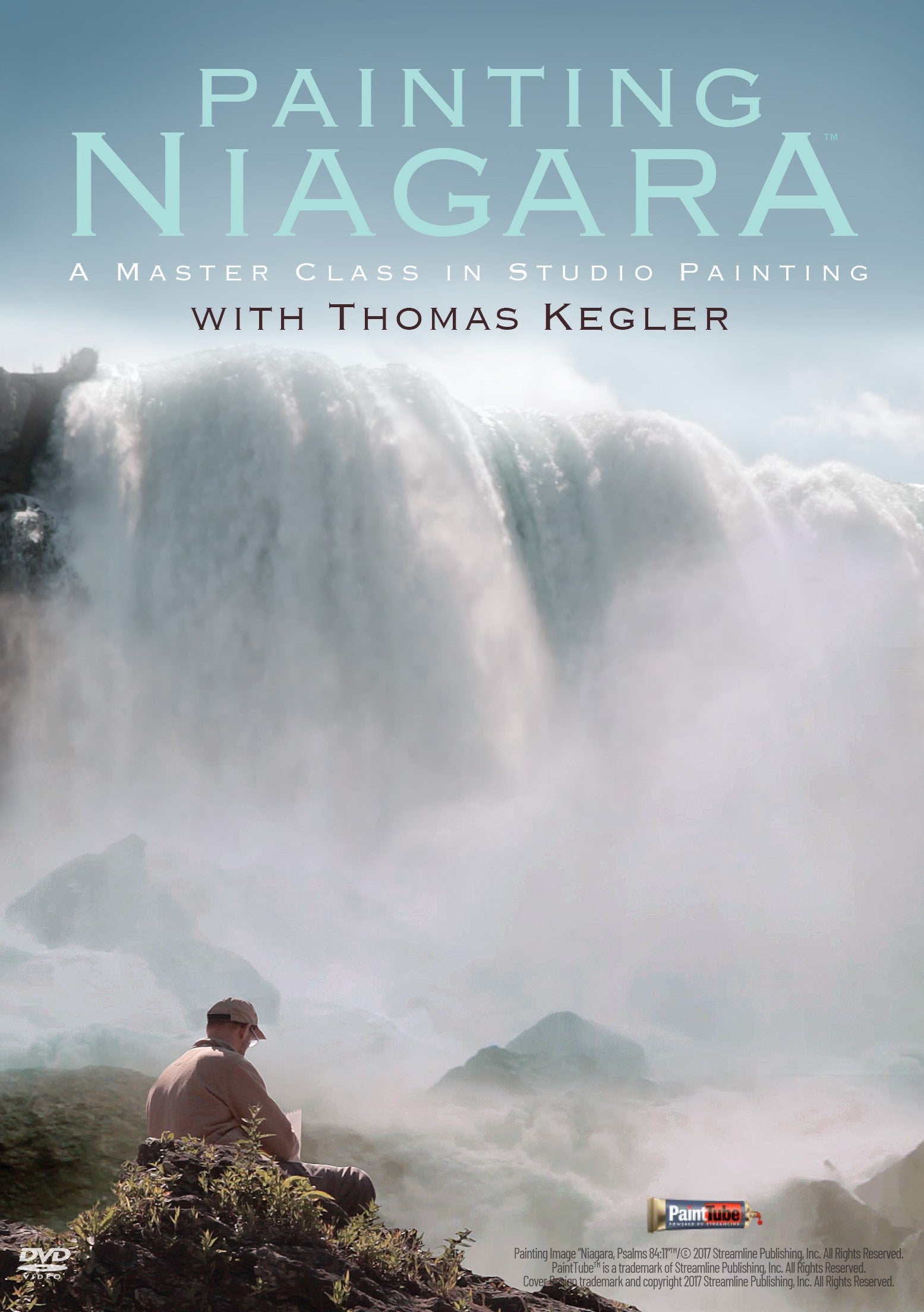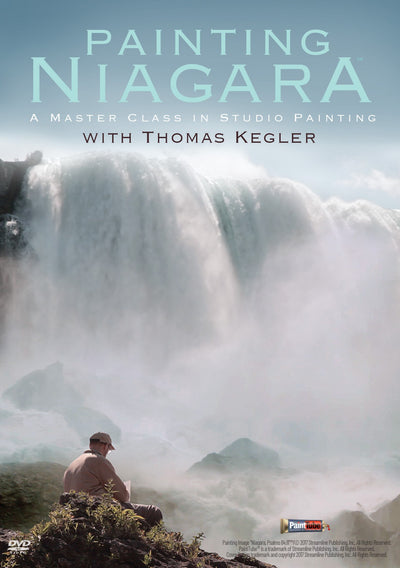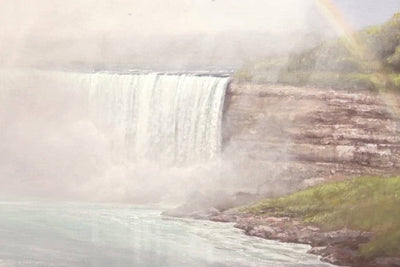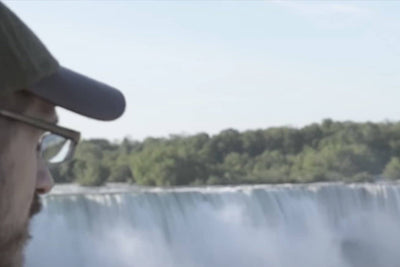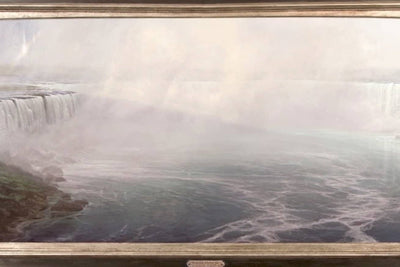Here are just a few techniques you will discover:
- How to perform your initial sketches and all the steps in preparation before you begin to paint...
- What you should consider in your notes and studies...
- How to transfer your drawing to a larger canvas without throwing off perspective
- The important first steps to prep your canvas to give you a perfect foundation, creating unity
Here Are Some of the Techniques You'll Discover
- The carpenter's tool Kegler uses as a critical part of his painting and preparation process
- How to block in a believable sky and prepare it for atmosphere and mist
- How to mass in the "dead colors" for the trees, the cascade of the falls, and the moss-covered rocks at the bottom of the escarpment
- How to paint the color shifts in the dome of the sky, and where to place your darker and lighter colors
- How to obscure your brushstrokes and hide the forms so you can create the illusion of a deep sky
- The essential brushstrokes Thomas makes when he lays in the tree forms (in boththe foreground and background)
- How he designs the cloud structures and highlights, and the color mixtures he uses to do this
- How to convey moss growth on the rocks
- How to check measurements, proportions, and alignment to make sure you are on track as you go
- How he develops the face of the rock cliff and the colors, creating a sense of reality
- How to create edges so they feel more natural
- The unexpected tool Thomas uses to create a sense of texture
- How to soften edges using special tools
- How to play cool and warm colors against one another to create a feel for temperature
- What to do at the water's edge to make your painting feel believable
- Mixing secrets to give the paint a touch of transparency to mimic the effect of water
- How to paint the magical effect of the sunlight hitting leaves and foliage
- The brushes Thomas uses to work on the multiple water forms in the various sections of the waterfalls
- The way to apply the paint to enhance certain areas of your painting
- Ways to paint the tree masses that sit BEHIND the falls and create distance
- How to paint a rainbow and avoid the mistakes almost every painter makes
- How to add realistic details, like sun flares in your rainbow
- Three critical reasons you need to apply varnish in certain spots
- How to design and create a beautiful custom frame for your work
- How to paint trees and leaves that make viewers feel they are inside the forest
- How to piece dozens of drawings and oil sketches together to create a unified painting
- Thomas Kegler's entire step-by-step process, which he teaches in the Hudson River Fellowship
and this is just the tip of the iceberg.
Sound difficult? It's not!
Would you like to learn how to use Thomas Kegler's master techniques to paint a breathtaking studio painting that will leave your viewers awestruck?
You don't need to be an experienced painter to learn how to do this.
And you don't have to have talent to paint. That comes from training.
In fact, in the words of our publisher, B. Eric Rhoads, if you can follow a recipe and bake a cake, you can learn to paint. Because painting is a process.
About the Artist:Thomas Kegler
Thomas Kegler's lifetime goal as a painter was to master the techniques used by renowned Hudson River School painters of the 19th century. Entirely self-taught, Kegler felt a special connection to these artists and their techniques, but after years of trial and error, he was unable to give his paintings the feeling captured by these historically important painters.
Tramping through endless woods with his easel on his back, Kegler sought out the very locations where important Hudson River paintings were crafted. Returning time and again, he sketched the locations, then painted plein air studies, trying to understand and capture the nuances and subtleties of distant mountains, mist-filled atmosphere, and lush forests. A scientist at heart, Kegler kept detailed notes on every process he attempted, experimenting with colors, glazing, underpaintings, and mediums in order to understand and ultimately capture the same feel created by these masters.
After a decade of study, Kegler had reproduced what he felt were the masters' rich yet tasteful greens, the subtle reds of the pine needles they depicted on the ground cover, and their approach to drawing, well rendered but not "too perfect." Finally, he had mastered the techniques.
Yet Thomas became uncomfortable. He had an itch. He could not, in his mind, justify not finding a way to master the falls as the artists who came before him had. It was the one thing he felt he had to do in his life to feel he had reached the pinnacle as a modern Hudson River School painter. He had to master the falls.
Living nearby, Thomas would visit the falls as often as he could get away from his responsibilities as a husband and father and a high school teacher. He would gaze at the falls for hours, trying to figure out how to capture the scene. He looked from every angle, he made hundreds of sketches, and he did plein air studies of various parts of the falls in every imaginable weather and light condition. It had become his all-consuming passion as an artist.
Documenting it all on video, Thomas finished the painting, which was immediately met with national acclaim and now hangs temporarily in the Castellani Art Museum near the falls. Though it will eventually find a home in a major U.S. museum or in the hands of a leading collector, it is a sight to see, and one of the most spectacular accomplishments of any American artist in history.
Chapters
- Introduction
- Interview with Thomas Kegler
- Chapter 1.1: Materials
- Chapter 1.2: Idea and Study
- Chapter 1.3: Physics - Typography, Lighting
- Chapter 1.4: Physics - Rainbow
- Chapter 1.5: Composition
- Chapter 1.6: Esquisse & Ink Tonal Study
- Chapter 1.7: Indirect Painting
- Chapter 1.8: Space & Form
- Chapter 1.9: Poster Study
- Chapter 1.10: Mounting of Linen
- Chapter 2.1: Toning Canvas, Transfer, Grisaille
- Chapter 2.2: Massing in Dead Color
- Chapter 2.3: Underpainting Part 1
- Chapter 2.4: Underpainting Part 2
- Chapter 2.5: Underpainting Part 3
- Chapter 2.6: Underpainting Part 4
- Chapter 3.1: Sky, Distand Land, Top of Falls
- Chapter 3.2: Left Side; Falls, Trees, Moss
- Chapter 3.3: Rock Cliff, Lip and Base of Falls
- Chapter 3.4: Rainbow, Right Land, Right Falls
- Chapter 3.5: Rainbow, Sky, Trees on Right
- Chapter 3.6: Moss and Cliff on Right, Rocks
- Chapter 3.7: Right Falls, Sky, Atmosphere
- Chapter 3.8: Lower Water Expanse
- Chapter 3.9: Lower Water
- Chapter 3.10: Atmosphere, Shadow, Land, Light
- Chapter 4.1: Details Polished
- Chapter 4.2: Details
- Chapter 4.3: Final Details
- Chapter 4.4: Final Adjustments
- Chapter 4.5: Varnishing
- Chapter 5.1 Building Frame


